Dropping 5.5 kg (12 pounds) in just three days may seem tempting for those chasing fast results, but it’s crucial to understand how this extreme weight loss occurs—and why it’s risky for your health. Quick fixes may give immediate results, but they are neither safe nor sustainable. Let’s explore the methods behind rapid weight loss and the dangers they pose.
How Rapid Weight Loss Actually Happens
1️⃣ Severe Calorie Restriction
What It Is: Consuming far fewer calories than your body needs, often around 500–800 per day.
Why It Works: Drastically lowering calorie intake forces the body to burn stored glycogen, fat, and muscle for energy.
Reality Check: Most weight lost initially comes from water and glycogen, not fat.
2️⃣ Extreme Diets (Juice Cleanses & Detox Plans)
What It Is: Replacing meals with juices, teas, or broths labeled as “detox.”
Why It Works: These diets cut calories drastically and remove solid foods, leading to rapid water and glycogen loss.
Reality Check: The body already detoxes naturally via the liver and kidneys. These diets often deprive you of essential nutrients.
3️⃣ Diuretics or Water Manipulation
What It Is: Using diuretics, reducing sodium, or dehydrating yourself to shed water weight.
Why It Works: Rapid water loss appears as weight loss on the scale.
Reality Check: This isn’t real fat loss. Dehydration can cause dizziness, kidney issues, and electrolyte imbalances.
4️⃣ Colon Cleanses or Laxatives
What It Is: Using laxatives, enemas, or colon-cleansing products to empty the digestive tract.
Why It Works: Removing water and waste from the intestines causes temporary weight loss.
Reality Check: This can harm gut health, cause dehydration, nutrient deficiencies, and create dependency on laxatives.
5️⃣ Intense Exercise Combined with Severe Dieting
What It Is: Hours of strenuous exercise paired with extremely low-calorie intake.
Why It Works: Creates a large caloric deficit and burns energy quickly.
Reality Check: Overtraining and under-eating can lead to fatigue, injury, and long-term metabolic damage.
Why Losing 5.5 kg (12 Pounds) in 3 Days Is Unsafe
💧 Most Weight Is Water, Not Fat – Initial loss is mostly water, glycogen, and some muscle, not true fat.
🥗 Nutrient Deficiencies – Extreme diets often lack protein, vitamins, and minerals, weakening immunity and body function.
💪 Muscle Loss – Inadequate calories and protein force the body to break down muscle tissue.
⚡ Metabolic Slowdown – Severe restriction triggers “starvation mode,” slowing metabolism and making future weight loss harder.
🚨 Dehydration Risks – Methods that cut water intake or sodium can lead to dizziness, fatigue, kidney problems, and heat-related illnesses.
🧠 Mental & Emotional Stress – Restrictive diets may cause irritability, obsession with food, or binge-eating behaviors.
⏳ Temporary Results – Rapid weight loss rarely lasts; normal eating often brings back water, glycogen, and fat, leading to rebound weight gain.
Safer, Sustainable Ways to Lose Weight
✅ Eat a Balanced Diet – Focus on whole foods: fruits, vegetables, lean proteins, whole grains, and healthy fats. Avoid processed foods high in sugar and unhealthy fats.
✅ Create a Moderate Caloric Deficit – Reduce intake by 500–750 calories daily to lose 0.5–1 kg (1–2 pounds) per week safely.
✅ Stay Hydrated – Water supports metabolism, digestion, and overall health.
✅ Exercise Regularly – Combine strength training and cardio to burn fat, build muscle, and boost metabolism.
✅ Prioritize Sleep & Stress Management – Poor sleep and stress disrupt hunger hormones, making weight loss harder.
✅ Be Patient and Consistent – Gradual progress through small, consistent lifestyle changes ensures lasting results.
Quick fixes may sound tempting, but long-term health and sustainable weight management come from safe, consistent habits. Protect your body, nourish it, and let gradual, healthy changes lead to lasting success.
